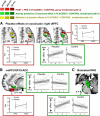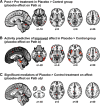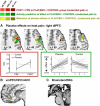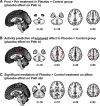Frontal-Brainstem Pathways Mediating Placebo Effects on Social Rejection
- PMID: 28264983
- PMCID: PMC5373138
- DOI: 10.1523/JNEUROSCI.2658-16.2017
Frontal-Brainstem Pathways Mediating Placebo Effects on Social Rejection
Abstract
Placebo treatments can strongly affect clinical outcomes, but research on how they shape other life experiences and emotional well-being is in its infancy. We used fMRI in humans to examine placebo effects on a particularly impactful life experience, social pain elicited by a recent romantic rejection. We compared these effects with placebo effects on physical (heat) pain, which are thought to depend on pathways connecting prefrontal cortex and periaqueductal gray (PAG). Placebo treatment, compared with control, reduced both social and physical pain, and increased activity in the dorsolateral prefrontal cortex (dlPFC) in both modalities. Placebo further altered the relationship between affect and both dlPFC and PAG activity during social pain, and effects on behavior were mediated by a pathway connecting dlPFC to the PAG, building on recent work implicating opioidergic PAG activity in the regulation of social pain. These findings suggest that placebo treatments reduce emotional distress by altering affective representations in frontal-brainstem systems.SIGNIFICANCE STATEMENT Placebo effects are improvements due to expectations and the socio-medical context in which treatment takes place. Whereas they have been extensively studied in the context of somatic conditions such as pain, much less is known of how treatment expectations shape the emotional experience of other important stressors and life events. Here, we use brain imaging to show that placebo treatment reduces the painful feelings associated with a recent romantic rejection by recruiting a prefrontal-brainstem network and by shifting the relationship between brain activity and affect. Our findings suggest that this brain network may be important for nonspecific treatment effects across a wide range of therapeutic approaches and mental health conditions.
Keywords: emotion regulation; nociception; opioid; placebo; resilience; social.
Copyright © 2017 the authors 0270-6474/17/373621-11$15.00/0.
Figures







Similar articles
-
Brainstem Mechanisms of Pain Modulation: A within-Subjects 7T fMRI Study of Placebo Analgesic and Nocebo Hyperalgesic Responses.J Neurosci. 2021 Nov 24;41(47):9794-9806. doi: 10.1523/JNEUROSCI.0806-21.2021. Epub 2021 Oct 25. J Neurosci. 2021. PMID: 34697093 Free PMC article.
-
Placebo-induced pain reduction is associated with negative coupling between brain networks at rest.Neuroimage. 2020 Oct 1;219:117024. doi: 10.1016/j.neuroimage.2020.117024. Epub 2020 Jun 5. Neuroimage. 2020. PMID: 32512124 Clinical Trial.
-
Prefrontal cortex modulates placebo analgesia.Pain. 2010 Mar;148(3):368-374. doi: 10.1016/j.pain.2009.09.033. Epub 2009 Oct 28. Pain. 2010. PMID: 19875233 Clinical Trial.
-
Mechanisms of placebo analgesia: A dual-process model informed by insights from cross-species comparisons.Prog Neurobiol. 2018 Jan;160:101-122. doi: 10.1016/j.pneurobio.2017.10.008. Epub 2017 Nov 3. Prog Neurobiol. 2018. PMID: 29108801 Free PMC article. Review.
-
Neurobiological mechanisms of placebo responses.Ann N Y Acad Sci. 2009 Mar;1156:198-210. doi: 10.1111/j.1749-6632.2009.04424.x. Ann N Y Acad Sci. 2009. PMID: 19338509 Free PMC article. Review.
Cited by
-
Transforming Pain With Prosocial Meaning: A Functional Magnetic Resonance Imaging Study.Psychosom Med. 2018 Nov/Dec;80(9):814-825. doi: 10.1097/PSY.0000000000000609. Psychosom Med. 2018. PMID: 29846310 Free PMC article.
-
Social pain: A systematic review on interventions.F1000Res. 2025 Jan 10;14:58. doi: 10.12688/f1000research.159561.1. eCollection 2025. F1000Res. 2025. PMID: 40144800 Free PMC article.
-
What's in a word? How instructions, suggestions, and social information change pain and emotion.Neurosci Biobehav Rev. 2017 Oct;81(Pt A):29-42. doi: 10.1016/j.neubiorev.2017.02.014. Neurosci Biobehav Rev. 2017. PMID: 29173508 Free PMC article. Review.
-
Placebos without deception reduce self-report and neural measures of emotional distress.Nat Commun. 2020 Jul 29;11(1):3785. doi: 10.1038/s41467-020-17654-y. Nat Commun. 2020. PMID: 32728026 Free PMC article. Clinical Trial.
-
Changes in neural processing and evaluation of negative facial expressions after administration of an open-label placebo.Sci Rep. 2022 Apr 21;12(1):6577. doi: 10.1038/s41598-022-10567-4. Sci Rep. 2022. PMID: 35449194 Free PMC article.
References
-
- Baumgärtner U, Buchholz HG, Bellosevich A, Magerl W, Siessmeier T, Rolke R, Höhnemann S, Piel M, Rösch F, Wester HJ, Henriksen G, Stoeter P, Bartenstein P, Treede RD, Schreckenberger M (2006) High opiate receptor binding potential in the human lateral pain system. Neuroimage 30:692–699. 10.1016/j.neuroimage.2005.10.033 - DOI - PubMed
Publication types
MeSH terms
Substances
Grants and funding
LinkOut - more resources
Full Text Sources
Other Literature Sources
Medical
